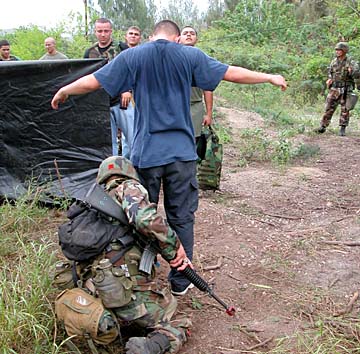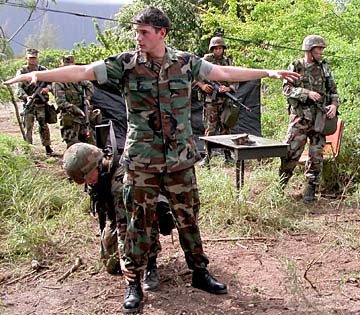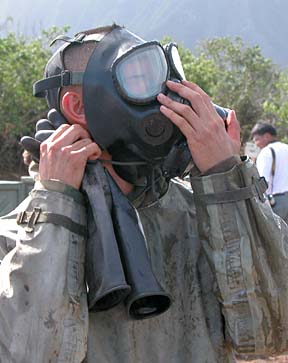


|
It's Marine Col. Jim Harbison's job to ensure that the infantry riflemen at Kaneohe Bay are well supplied with "the nuts and bolts of war." Marines training
for rescue missionIf Americans in the Pacific
are threatened by terrorism,
the Corps wants to be readyBy Gregg K. Kakesako
gkakesako@starbulletin.comWith the past 15 months since the tragedies of Sept. 11 at the World Trade Center and the Pentagon, the mission of Harbison's Combat Service Support Group 3 has taken on added emphasis.
He refers to the 1,000 Marines in his unit as "the glue that holds everything together."
The services of his unit range from administrative duties like mail service and legal assistance to medical and dental care. It also extends to providing airfields and roads that Marines need and to maintaining the Humvees and heavy-ton trucks that transport the Marines and their equipment.
No military unit can operate anywhere without a steady flow of food, fuel, water, ammunition and other necessities needed to fight. It is Harbison's job to ensure that these logistical lifelines are maintained.
For the past three weeks, Group 3 has been at Waimanalo's Bellows Air Force Station testing the skills it would need if sent on a humanitarian relief mission.

|
It's a scenario that was modified slightly to meet the global terrorist threat, Harbison said.This means an emphasis on the cleanup and disposal of nuclear, biological or chemical (NBC) agents and the operation of a center to evacuate Americans trapped overseas during a sudden terrorist takeover.
With Bellows doubling as "a country in the Pacific," Harbison said the initial scenario called for him to bring in about 600 Marines on a humanitarian assistance mission because the American embassy said "there were Americans at risk here."
"The situation was said to be benign when we got here," Harbison said, but then events started to unfold.
There were simulated terrorist attacks and Harbison was forced to call in an element of the 3rd Battalion, 3rd Marine Regiment, for assistance with their light armored vehicles to fight the terrorists.
The U.S. compound was hit with a sarin nerve-gas attack just before dusk and a decontamination site had to be hastily constructed to clean trucks, equipment and Marines.
Harbison's unit also established an evacuation control center to practice procedures that would be used to process U.S. citizens forced to flee.

|
First Lt. Eric Demsky said the purpose of the center was "to account for these Americans, stage and process them and then transport them to an airfield.""They would be given medical support at the center if they requested."
Cpl. David Robinson, embarkation NCO, said his main goal is "to get these people out of any hostile conditions."
Harbison said this type of strategic mobility exercise is the closest thing to being actually deployed.
During the exercise, which began Dec. 2 and will end Wednesday, the Marines practiced evacuating an "downed aircraft" with a Humvee filling in as a substitute.
There also were other problems sent to the unit via video teleconferencing calls and other means to simulate emergency messages and orders.
Throughout the exercise Harbison acknowledges that the Pentagon continues to plan for another war on Iraq.
However, Harbison, who served for two years as a planner for the Pacific Command at Camp Smith before assuming command last summer, said he doesn't believe his unit will be tapped.
"Generally, that is not our mission profile," Harbison said. "Our mission profile is the Pacific."